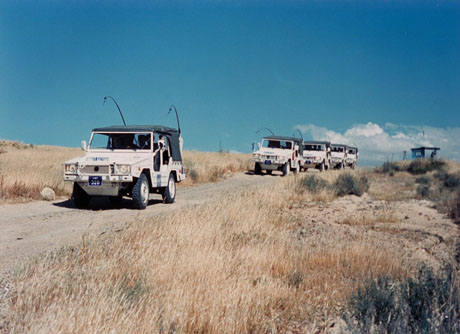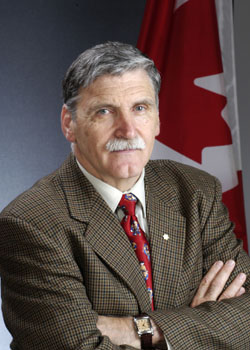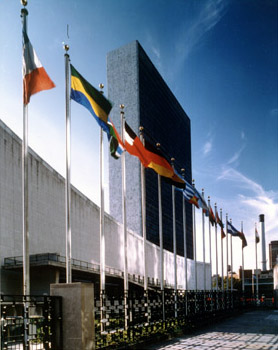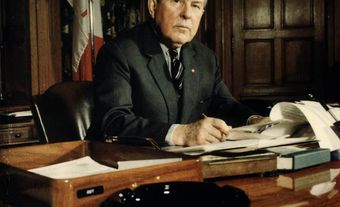Peacekeeping is the term usually applied to United Nations (UN) operations in countries affected by conflict. Peacekeepers work to maintain peace and security, protect human rights and help restore the rule of law. Peacekeepers can be members of the armed forces, police officers or civilian experts. As a result of Lester Pearson's leadership in the 1956 Suez Crisis and Canada's role in the UN Emergency Force he helped create, many Canadians consider peacekeeping part of the country's identity. However, since the 1990s Canada's reputation as a peacekeeping nation has been affected by scandal and by the failure of some overseas missions. Although Canada’s contribution to peace operations has declined since then, Canadian peacekeepers continue to serve overseas in such places as Sudan and the Democratic Republic of Congo. In total, more than 125,000 Canadians have served in UN peace operations. Canadians have also participated in UN-sanctioned peace operations led by NATO and in missions sponsored by the Multinational Force and Observers (MFO). Approximately 130 Canadians have died in peace operations.
Key Facts about Canadian Peacekeeping
|
How many Canadian have been involved in peace operations? |
In total, more than 125,000 Canadians have served in peace operations. |
|
How many Canadian peacekeepers have died? |
Approximately 130 Canadians have died in peace operations (123 in UN missions). |
|
How many Canadians are currently serving in peace operations? |
Approximately 100 Canadians were serving in peace operations as of 30 April 2024 (40 in UN missions). |
Early UN Interventions
The United Nations Charter, which was drafted at the end of the Second World War in 1945, included measures to maintain international peace and security. However, Cold War tensions between the United States and the Soviet Union prevented attempts to create a permanent UN force. Instead, the UN sent temporary military forces (at first only military observers) into the world's regional hotspots.
This was first tried in April 1948, when the UN sent military observers to the disputed Pakistan-India region of Kashmir. In May, military observers were posted along the Arab-Israeli borders (Palestine). In theory, military observers were impartial mediators, watching the movements of warring armies, supervising ceasefires and protecting local civilians. Canada provided eight officers for the UN force in Kashmir. After 1953, Canada also sent four officers to the force in Palestine, including Major-General E.L.M. Burns, who took command of the UN force there in February 1954.
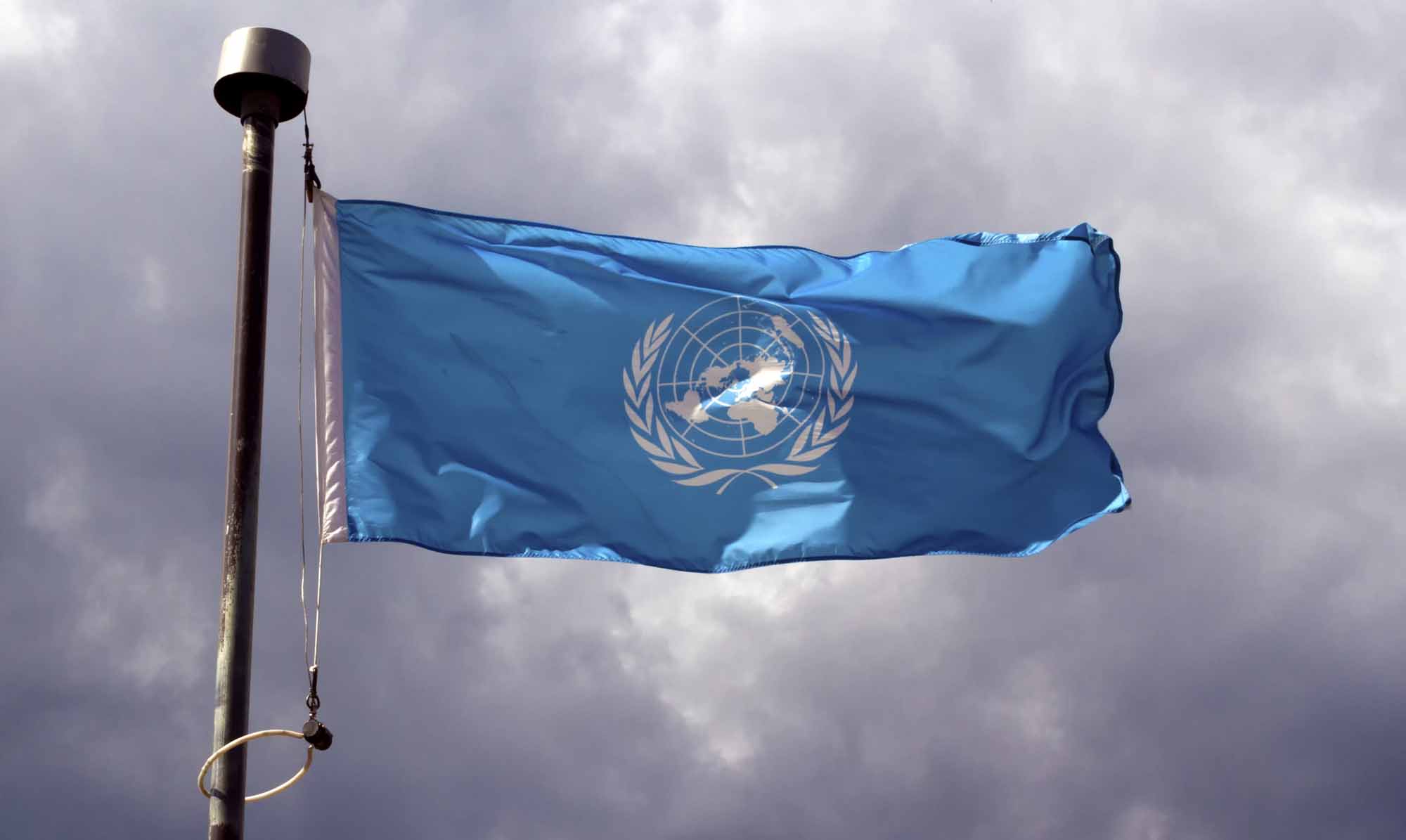
The United Nations also intervened when the Korean War broke out in 1950. However, this was very different from peacekeeping. Under the umbrella of the UN, the United States organized what was called a "police action" to resist the North Korean invasion of South Korea. The US-led military forces, including those from Canada, engaged in full warfare under the UN banner.
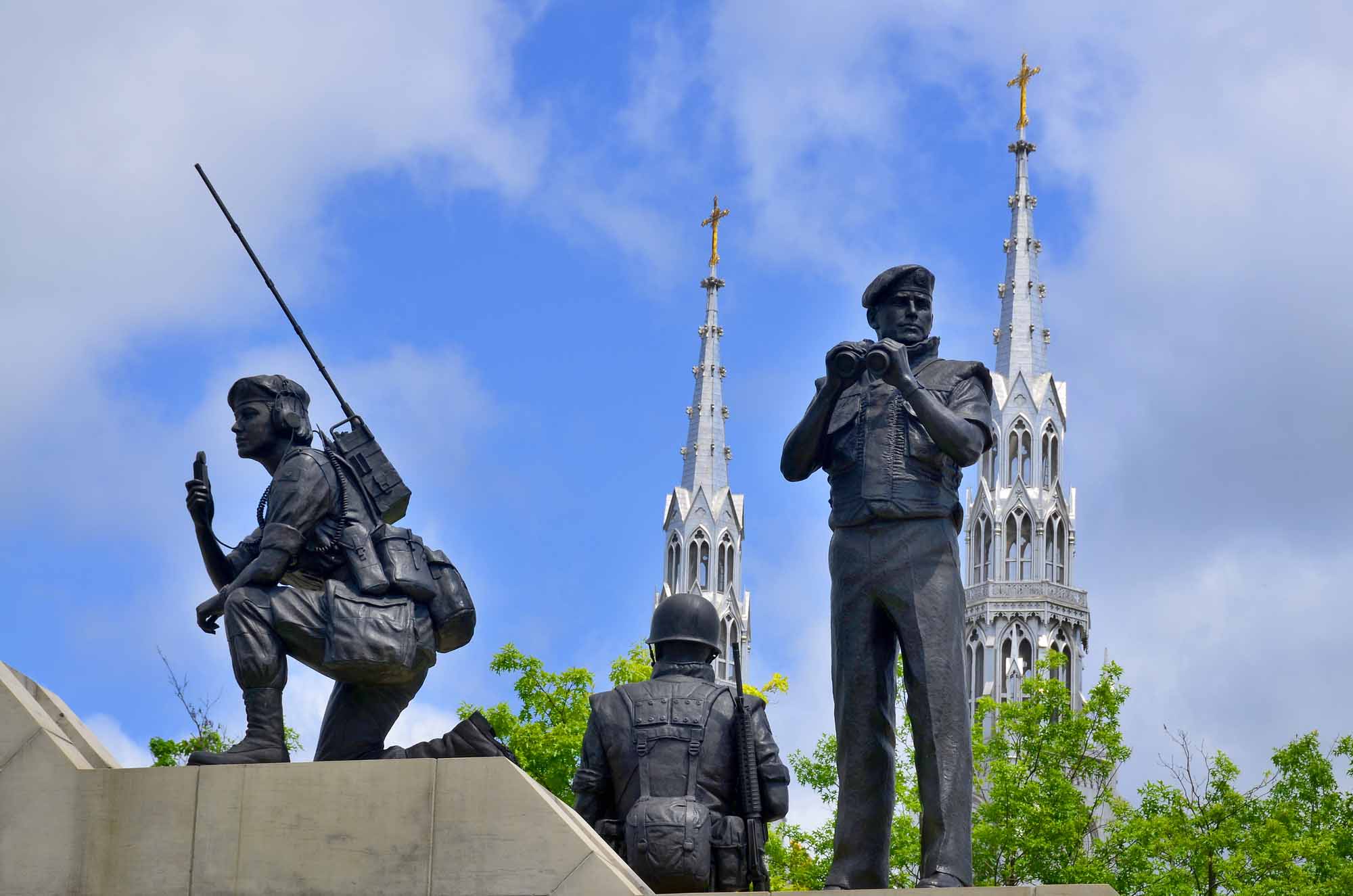
International Commissions in Vietnam, Laos and Cambodia (1950s and 1960s)
In the 1950s, Canada also played a role in the International Commissions for Supervision and Control in Vietnam, Laos and Cambodia. These commissions were non-UN efforts, and were usually called International Control Commissions (ICCs). They were set up by the Geneva Conference of 1954 on a "troika" model, with an Eastern or Communist-bloc state, a Western state, and a neutral state (e.g., in the case of the southeast Asia ICC, this meant Poland, Canada and India).
The ICC task was complex. It included relocating populations displaced by war, supervising elections and monitoring new boundaries. The manpower commitment was quite heavy: 133 Canadian military observers and a substantial number of External Affairs officials. In Cambodia and Laos, there was initially some success. However, the Vietnam ICC was unsuccessful, as the civil war there spread out of control in the 1960s.

Lester Pearson and the Suez Crisis
In 1956, the Egyptian government nationalized the Suez Canal, which was a vital route for oil travelling to Britain (see Suez Crisis). This concerned Western nations and led Britain, France and Israel to attack Egypt. However, they did so without informing the US, Canada or other NATO allies. Canada wanted to minimize the harm done to the Western alliance by the Anglo-French attack. At this time, Lester Pearson was Canada's secretary of state for External Affairs. Working with UN Secretary-General Dag Hammarskjöld, Pearson suggested creating a peacekeeping force to stabilize the situation and to permit the withdrawal of the attacking forces. Pearson also offered a battalion of Canadian troops. The United Nations Emergency Force (UNEF) was quickly formed and placed under the command of Canadian Major-General E.L.M. Burns.
To Canada's surprise, Egyptians objected to the presence of Canadian troops. The uniforms, the regimental names and Canadian flags (at this time the Red Ensign) seemed very similar to those of the British invaders. The Egyptians argued that their people would not understand any distinction between the two. As a compromise, Canada did not send infantry soldiers. Instead, it sent a reconnaissance unit, signals and supply troops, and helped airlift personnel and cargo. These were all vital to the success of the UN mission.
This experience played a part in convincing Pearson, who later became prime minister, that Canada needed its own symbols, including a distinctly Canadian flag. It also won him the Nobel Peace Prize. It left Canadians with a sense of pride and ownership over the UN peacekeeping idea — which was used increasingly in conflict situations around the world.
Canadian Peacekeeping Missions (1960s to 1980s)
After Suez, many Canadians regarded peacekeeping as a national duty. This became clear in July 1960, when a newly independent Republic of the Congo erupted in violence. When the UN asked for signalers and other troops, the government of Prime Minister John Diefenbaker was reluctant to participate. However, public opinion supported involvement in the mission, forcing the government’s hand. Canada therefore sent soldiers to Congo.
Peacekeeping's popularity among Canadians had been established. In 1962, the government didn’t hesitate to send a small number of men to West (Papua) New Guinea. The following year, Canadian soldiers went to Yemen to serve with a UN observer mission. A much larger commitment followed in 1964, when the UN intervened to separate Greeks and Turks in Cyprus. Paul Martin Sr., secretary of state for External Affairs, helped create the Cyprus UN force. Cyprus remained one of Canada's major foreign commitments for several decades.
By the late 1960s, however, support for peacekeeping was already in decline. Some critics were beginning to complain that peacekeeping merely kept situations static and did nothing to resolve them. Others worried about costs and casualties and unclear mandates. In what circumstances, for example, could peacekeepers use deadly force: To defend themselves? To defend civilians?
A severe blow to the peacekeeping ideal came in 1967, when Egyptian President Gamal Abdel Nasser ordered the UNEF out of Egypt. The Egyptian government singled out the Canadians, requesting their immediate withdrawal. Another Arab-Israeli war followed. To many, the expulsion of Canadian peacekeepers was a national humiliation. Around the same time, there were charges that Canadians in the International Control Commissions (e.g., in Vietnam) had been spying for the US. This contributed to declining support for peacekeeping in Canada.
In the late 1980s, Prime Minister Brian Mulroney’s government seemed more willing to consider UN requests for peacekeeping troops. By this time, however, peacekeeping had become a chore rather than an opportunity for many Canadian service personnel. It was also unclear how much support there was for UN peacekeeping among Canadians.
Still, Canadians shared in the pride of the 1988 Nobel Peace Prize, which was awarded to the UN for its decades of peacekeeping work. Canada had played a large role in that work, contributing 80,000 personnel — roughly 10 per cent of the total UN forces sent on peacekeeping missions — between 1948 and 1988.
Canadian Peacekeepers in the Balkans
The end of the Cold War and of Soviet influence in international affairs left power vacuums throughout the world. Many former Soviet-bloc states in Asia and Europe, notably Yugoslavia, disintegrated into ethnic conflict. The UN sent an international peacekeeping force to the Balkan region, where several of the former Yugoslav republics were in the midst of civil war. Canadians made up a large part of the mission forces.
The Balkans were a difficult and dangerous place for peacekeepers, because there was no real peace to keep between the still-warring ethnic groups. In 1992, UN forces led by Canadian General Lewis MacKenzie came under constant fire during the siege of Sarajevo, Bosnia-Herzegovina. In 1993, soldiers of the Princess Patricia's Canadian Light Infantry, serving with the UN in Croatia, fought Croatian forces in the Medak Pocket. This was the heaviest combat experienced by Canadian forces since the Korean War. ( See Canadian Peacekeepers in the Balkans.)
Canadian Peacekeepers in Somalia
Although the missions in the Balkans were difficult, it was the mission to Somalia that really harmed the image of Canadian peacekeeping. Somalia had descended into famine and lawlessness, and from 1992 to 1993 Canadian forces participated in both a UN mission and a US-led international military coalition effort to restore order and allow the distribution of humanitarian supplies across the country (see Canadian Peacekeepers in Somalia).
Along with other coalition forces, Canadian troops came under fire from Somali warlord armies while trying to guard port facilities, fly helicopter reconnaissance flights and escort food convoys. Numerous coalition troops, including one Canadian, lost their lives.
In 1993, two Canadian paratroopers serving in Somalia beat and tortured a local teenager to death. A dozen more Canadian soldiers had been aware of the beating but did nothing to stop it. The resulting scandal prompted a high-profile public inquiry in Canada. It severely damaged Canada’s reputation as an agent of peacekeeping, embarrassed the government of Prime Minister Jean Chrétien, and led to the disbanding of the army's disgraced Airborne Regiment. (See Somalia Affair). Internationally, the UN’s experience in Somalia meant that it was unwilling to intervene decisively in the next crisis: the genocide in Rwanda.
Canadian Peacekeepers in Rwanda
In 1994, genocide and ethnic cleansing broke out in Rwanda. The previous year, Canada had sent more than 400 troops to Rwanda as part of a UN mission to bring stability and order to the small African nation. The mission was commanded by Canadian General Roméo Dallaire. However, there was little peacekeepers could do to keep the peace or prevent the genocide, as they were not allowed to use force. Dallaire requested more troops and permission to take preventive action but was denied by the UN.
The experience in Rwanda demonstrated the limited power of peacekeeping forces in such situations and the inefficiency of the UN in terms of crisis decision making. The capture, torture and murder of 10 Belgian peacekeepers in Rwanda further eroded public support for peacekeeping. Dallaire's harrowing experience trying to command a small, beleaguered peacekeeping force during the genocide made him a household name in Canada. (See Canadian Peacekeepers in Rwanda.)

New Era in Canadian Peacekeeping
The challenges and lessons of Bosnia, Somalia and Rwanda— where there was little or no peace to keep — soured Canadian attitudes towards peacekeeping activities. From 2001 to 2014, much of Canada's foreign policy, and military effort, was directed not to peacekeeping but to the War in Afghanistan. At the same time, Canada nominally participated in several UN missions, sending troops and/or police officers to Ethiopia and Eritrea, Liberia, the Ivory Coast and Sudan. In each case, only a handful of Canadian military and police advisors were sent abroad. Overall, Canada’s participation in UN peacekeeping missions has declined since the 1990s. In December 1992 for example, Canada contributed 3,825 personnel to UN peace operations. In contrast, 176 Canadians were involved in UN peace operations on 30 June 2019. According to UN reports, this number had decreased to 40 Canadian peacekeepers in UN missions as of 30 April 2024.
SHIRBRIG
In 1996, Canada was one of seven countries to found and commit troops toward the Multinational Stand-By High Readiness Brigade for United Nations Operations (SHIRBRIG). The creation of this brigade allowed the UN to quickly send a professional force to conflict areas. According to the UN, "Experience has proven that the rapid deployment of military assets within the first six to seven weeks after a Security Council mandate is crucial for the success of a peacekeeping operation." SHIRBRIG was deployed five times between 2000 and 2006 and was commanded by Canada from 2003 to 2006. Ultimately SHIRBRIG was disbanded by its member states, including Canada, in 2009.
Changing Nature of Peacekeeping
The nature of peacekeeping has changed since the 1990s. Peace operations are now multidimensional. In addition to helping maintain peace and security, peacekeepers also protect human rights, help restore the rule of law and help organize political elections.
Canadian Peacekeepers in Haiti
Since 1990, members of the Canadian Armed Forces (CAF) and civilian police forces, including the Royal Canadian Mounted Police (RCMP), have served in Haiti on various UN peacekeeping missions. The purpose of these missions was to help stop the internal violence and civil unrest that had plagued the country for years, and to help protect human rights and strengthen police and judicial systems. The highest number of Canadian personnel in Haiti at any one time was a 750-person contingent of infantry, reconnaissance, engineers, helicopters and logistics personnel in 1996–97. Beginning in 2017, Canadian police officers were involved in the UN Mission for Justice Support in Haiti (MINUJUSTH). The mission completed its mandate on 15 October 2019. Canadian police officers have been involved in the United Nations Integrated Office in Haiti (BINUH) since 2019. (See Canadian Peacekeepers in Haiti.)

Canadian Peacekeepers in Mali
From June 2018 to November 2023, members of Canada’s armed forces and police services have supported the United Nations Multidimensional Integrated Stabilization Mission in Mali (MINUSMA). Following a rebellion and coup in 2012, the country suffered from violence and instability. Canada’s primary role was providing medical evacuation of UN forces by air. The Canadian Air Task Force — three CH 147-F Chinook helicopters, five CH 146 Griffon helicopters and about 250 personnel — could also assist in other MINUSMA operations, including the rapid deployment of UN forces in Mali and the transportation of supplies. The Canadian Air Task Force withdrew from Mali in August 2019. A contingent of police and staff officers were involved in MINUSMA until 16 November 2023, when the last five personnel returned home. This was in response to a request in June 2023 from the Transitional Government of Mali for a progressive withdrawal of UN peacekeepers.
Where are Canadian Peacekeepers Today?
In total, 40 Canadians (28 men and 12 women) were involved in UN peace operations as of 30 April 2024. This included 18 staff officers, 18 police officers and four “experts on mission.” The largest contingent (24) was deployed in peace operations in the Democratic Republic of Congo (MONUSCO). Nine Canadians were involved in peace operations in Sudan (UNMISS), one in Cyprus (UNFICYP), two with the United Nations Integrated Office in Haiti (BINUH) and four with the United Nations Truce Supervision Organization (UNTSO) in the Middle East.
Canada also contributes five CAF personnel for logistics and headquarters support to Kosovo Force (KFOR), a peace support operation led by NATO. Approximately 55 Canadians are involved in the Multinational Force and Observer (MFO) mission in the Sinai Peninsula, which helps to maintain the Egypt-Israel Peace Treaty (signed in 1979). Canada has been involved in the MFO since 1985.
Remembering Canadian Peacekeepers
Canada's peacekeepers are honoured and remembered at the national peacekeeping memorial — titled Reconciliation — in downtown Ottawa. In addition, the names of those killed on peacekeeping missions since 1947 are inscribed in the Books of Remembrance in the Memorial Chamber on Parliament Hill. In 2008, Canada established National Peacekeepers Day (August 9). Every year since then, a ceremony has been held on the Sunday closest to 9 August at the Peacekeeping Monument in Ottawa.


 Share on Facebook
Share on Facebook Share on X
Share on X Share by Email
Share by Email Share on Google Classroom
Share on Google Classroom
